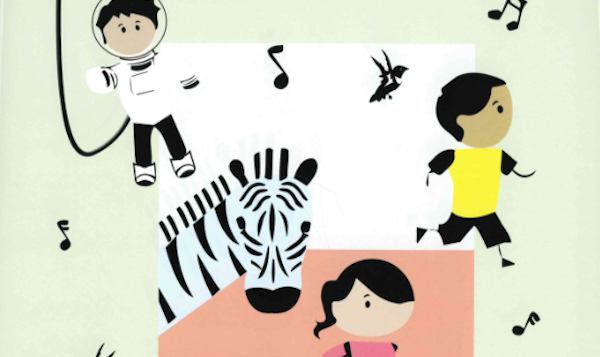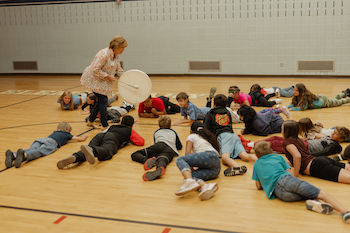SUBJECTS
GRADE
Show Results
Fall in Line, Holden! Dance and Movement

Lesson Summary
- Students will express movement and dance ideas inspired by the book Fall in Line, Holden!
Lesson Plan and Procedure
Lesson Key Facts
- Grade(s): K, 1, 2, 3
- Subject(s): Dance, Health, Native American
- Duration of lesson: 20-30 minutes
- Author(s): Cally Flox with Yvette May
There is power in the arts and in personal creativity. Participation in the arts can be a healing experience. It is a way to freely express strong feelings in a safe and meaningful way. Artistic imagination inspires wonder, helping us get through hard times and encouraging hope during personal challenges.
Background knowledge: This dance activity explores the feelings presented in the book Fall in Line, Holden! Students will use their bodies to express how it feels to comply with the directives of others and compare and contrast how it feels to explore their own self-directed patterns. Before teaching, prepare a large movement space in your classroom. Establish the safety parameters for the space with the students. As needed, remind children of personal space and appropriate, respectful behavior during movement sequences.
Lesson
Introduce the book
Teacher: Fall in Line, Holden! is written and illustrated by a Dine’ (Navajo) author, named Daniel Vandever. He wanted to use his artistic talents to share that every child matters. In his book, he shows us how Native American boarding schools gave a very different kind of life and education from the way indigenous children were raised and taught in their homes and communities. This was especially hard for the children. The story features a young boarding school student, named Holden. See how Holden is able to express his own thoughts and feelings by using his imagination and creativity. Every child matters.
Read Fall in Line, Holden! to the children to prepare for the movement experience.
Teacher: What was the boarding school experience like for Holden? What were some of the things Holden did every day at school? How did Holden use his imagination at school? Let’s explore some of these ideas, using movement and dance.
Movement Activity
Invite students to stand and move into a straight line behind you, follow-the-leader style, holding your drum.
Through-out this activity, use these verbal cues, when starting and finishing movement
sequences:
Teacher: “When the drum starts, you go. When the drum stops, you stop. Hold your shape.”
Begin with the students marching in a line, behind you, making curving and straight lines to your 4/4 steady drum beat.
Teacher: How does it feel to move all together? Remember when Holden saw the animals on the wall? This time, as we go marching together, when the drum stops, make the shape of one of the animals hanging on the wall.
Lead the line and play the steady beat in 4/4 time, while students march. When the drum stops, children will freeze in a shape inspired by one of the animals. Look around the room. Notice and affirm individual students.
Teacher: Wow! I see a zebra, a lion, a giraffe…. Nice job! When the drum starts again, show how your animal sneaks through the grass... Start where you are and move through the space as if you are sneaking up on another animal or sneaking away.

Play various sneaking through grass drum rhythms and sounds, rubbing the top of the drum, quietly scratching with your fingernails, etc. Include some surprise sounds, while students move about the space.
Teacher: Let’s all explore some more animal ideas. Show me how an animal would:
- Gallop
- Run
- Leap
- Pounce
Play the drum and give a new locomotor prompt (gallop, run, leap, pounce), every 5-15 seconds, when the children seem ready.
Teacher: Now, think about one of the animals. How does your animal hunt? How does it run and pounce…Can you do it bigger? Can you do it slower? Faster?
Allow the drum beats to change to support the movement ideas. Acknowledge individual students for their artistic movement choices. When ready, stop beating the drum and call out loudly...
Teacher: Fall in line, Holden!
Return to the steady marching beat of the drum. Children respond to the cue by returning to marching in line behind you, follow-the-leader style.
Teacher: Nice job! We are all moving together again, in the same pattern.
Freeze; drum beat: Play a strong accent beat and stop.
Teacher: Remember the custodians? What did Holden see in his imagination when he saw them? Clowns are in the circus. They are playful and goofy. They swing and twirl and do funny things. Can you swing and twirl?
Allow the drum beats to change to support the movement ideas. Use a 3/4 time meter to support swinging and twirling. Acknowledge individual students for their artistic movement choices.
Teacher: What else could you imagine about the custodians? How would they dance if they were mopping? Washing windows? What else could you imagine the custodians to be? Could they be dancers, athletes, or musicians?
You choose….
Use a variety of contrasting drum beats, even tempo and uneven patterns to accompany the children’s movement. Even tempo and uneven patterns, marching beat 4/4 time, or 3/4 time beat mixed with syncopated and uneven beats.
Teacher: Now it’s your turn to choose. You can be anything. Dance what your imagination sees! What are you going to do?

Invite several children to share the idea they plan to dance. so, the other children can get plenty of ideas.
Provide a variety of rhythmic accompaniment tempos. Acknowledge individual students for their artistic movement choices. End this sequence with a strong final beat.
Express appreciation for student effort and creative participation.
Concluding Discussion:
Lead this discussion using some of the following questions, and including your own ideas.
Teacher: Why do we follow directions? When? Why do we need to be able to express our own ideas?
Teacher: How does it feel to march in a line? How does it feel to move with some freedom? How does it feel to come up with your very own idea? What are you comfortable with? Why? What is the value of both ways?
Student answers may vary, but could include:
- Following directions keeps us safe, tells us what to do while we learn something, keeps us cooperating as members of a community, or allows us to complete shared tasks, like getting lunch for a large group.
When we dance our own ideas, we show we are unique. We can be creative and express how we see something individually, differently from others.
Express appreciation to the children and let them know that you value and respect their uniqueness, individuality, creativity, and differences. You also appreciate their willingness to work together and follow instructions. These are important for learning, safety, personal growth, and happiness.
Learning Objectives
- Students will understand themselves and others better by exploring the ideas of compliance, personal voice, and creative expression.
- Students will respond with movement to specific drumming patterns, 3/4 time, 4/4 march, skipping beat, skipping rhythm, galloping rhythm, and rhapsodic rhythm patterns.
- Students will move in directed and self-directed patterns.
Utah State Board of Education Standards
This lesson can be used to meet standards in many grades and subject areas. We will highlight one grade’s standards to give an example of application.
Dance Grade 2
Standard 2.D.CR.2: Explore movement inspired by a variety of stimuli.
Standard 2.D.CR.3: Express an idea, feeling, or image while improvising a dance that has a beginning, middle, and end.
Standard 2.D.CR.4: Reflect on movement choices and change movement through guided improvisational experiences or short remembered sequences.
Standard 2.D.P.1: Move safely in general space through a range of activities and group formations while maintaining personal space.
Standard 2.D.P.3: Move body parts one at a time and in a variety of combinations.
Standard 2.D.P.5: Identify and demonstrate contrasts in tempo and rhythm through movement.
Standard 2.D.P.6: Demonstrate a variety of movement qualities while dancing.
Standard 2.D.CO.1: Observe a work of visual art asking questions for discussion, then describe and express through movement something of interest about the artwork.
Health Grade 2
Standard 2.HF.4: Practice active-listening skills.
Standard 2.MEH.2: Describe ways to respond to uncomfortable emotions or situations.
Equipment and Materials Needed
- Book: Fall in Line, Holden! By Daniel Vandever
- For teacher’s use only: In preparation for sharing this book with your class, watch this video with helpful author commentary: Virtual Reading with Daniel Vandever (Diné author of Fall in Line, Holden and Herizon)
- Set the video to where the book begins, about 7:17.
- Handheld drum for accompaniment
- Classroom space for creative movement
Additional Resources
This lesson was created thanks to a grant from the National Endowment for the Arts and the Utah Division of Arts & Museums.
Image References
Image 1: Back cover of Fall in Line, Holden! written and illustrated by Daniel Vandever
Images 2-3: Samuel Jake

www.education.byu.edu/arts/lessons
 Download
Download